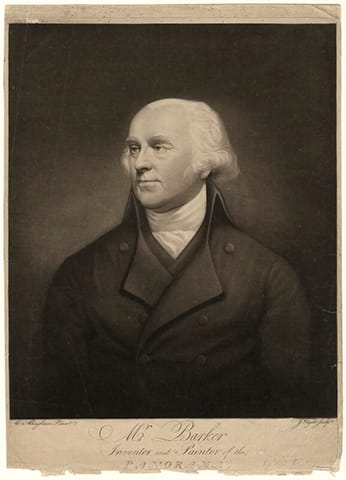Robert Barker: Inventor of the "Panorama" Image

The itinerant portrait painter Robert Barker coined the word "panorama", from Greek pan ("all") horama ("view"), in 1792 to describe his paintings of Edinburgh, Scotland, shown on a cylindrical surface, which he soon was exhibiting in London, as "The Panorama".
The Barker Panorama of Edinburgh from Calton Hill is considered to be the earliest panorama view and held within University of Edinburgh. This six piece set of engravings show a 360 degree view of the city of Edinburgh from a standing position on Calton Hill.1
Shown below is an incomplete non-aqua-tinted version of the earliest panorama view. This panorama is composed of only four of the full collection of a six part set.1

In 1793 Barker moved his panoramas to the first purpose-built panorama building in the world, in Leicester Square, and made a fortune. Viewers flocked to pay 3 shillings to stand on a central platform under a skylight, which offered an even lighting, and get an experience that was "panoramic" (an adjective that didn't appear in print until 1813). The extended meaning of a "comprehensive survey" of a subject followed sooner, in 1801. Visitors to Barker's semi-circular Panorama of London (see below), painted as if viewed from the roof of Albion Mills on the South Bank, could purchase a series of six prints that modestly recalled the experience; end-to-end the prints stretched 3.25 meters. 2

Above is the Panoramic view of London, from the top of Albion Mills which was by the south end of Blackfriars Bridge. Although the original drawings on which the work is based are generally attributed to Robert Barker and are likely to have been made with his involvement, it was his son, Henry, who was sent onto the roof of Albion Mills to make the earliest studies for the work in the winter of 1790–91. Henry also produced the outline etching of the scene, which was later aquatinted by printmaker Frederick Birnie.1
Robert Barker's sons were also involved in their father's success though in different business roles.
Robert Barker died April 8, 1806, and was buried at Lambeth, Surrey. Barker's oldest son, Thomas Edward Barker, although not an artist, was also involved in running the family business, but later set up a rival panorama exhibition with the painter Ramsay Richard Reinagle at 168/9 The Strand, London.2
The younger son of the now famous artist, Henry Aston Barker, assisted with and then carried on his father's profession of painting and exhibiting panaoramas. Born in Glasgow, he was, by the age of twelve set to work making outlines of the city of Edinburgh from the top of the Calton Hill Observatory, and a few years later made the drawings for the view of London from Albion Mills (as mentioned above). He later made etchings after these drawings. In 1788 Barker moved to London with his father, and soon afterwards became a pupil at the Royal Academy. He continued to be his father's chief assistant in the panoramas until the latter's death in 1806, when, as executor, Henry took over the business, and carried on the exhibitions for 20 years with great success.2
You can read more about the Barker art business on Wikipedia and by following the bookmark link below to the Jane Austen site which has some interesting images from Barker's works.

The Madman's Gallery by Edward Brooke-Hitching also has some interesting information about Barker's Panoramic Paintings which apparently were so large that visitors were given maps to find their way around. In 1794, King George Ill and Queen Charlotte were given a private viewing. Barker's vast panorama of a naval scene was so realistic and overwhelming that Queen Charlotte, after staring out across the painted ocean, was struck down with seasickness. This story, of course, did wonders for Barker's publicity, and panoramas became the entertainment hit of the time. Londoners paid three shillings for views of London, which were made so effective by Barker's accomplished technique of manipulating perspective better than the 'wide-angle' style used by previous artists.3
The artworks were hugely profitable for Barker but also for London's artistic community. Copycat panorama shows sprang up all over town — evidence reveals that between 1793 and 1863 at least 126 different panoramas were exhibited in London, and all were in need of skilled painters. 3
Such monster panoramas sit at the heart of modern cinema — the popularity of the static panorama gradually giving way to the 'moving panorama', which were enormously long paintings that an operator slowly rolled before an audience like scenery passing by a train window. In America, for example, the most famous of these were the panoramic scenes of the Mississippi Valley by John Banvard (1815-91), which he toured from 1840. Banvard's largest panorama was his 'three-mile canvas' (as he branded it), which was actually about 0.8km (½ mile) long. With the profits from touring his work he was able to build a giant imitation of Windsor Castle on Long Island, which was nicknamed 'Banvard's Folly'. Gradually, these moving panoramas gave way to the popularity of moving pictures — and cinema was born.”3
Credit
1. en.wikipedia.org
2. janeausten.co.uk/blogs/authors-artists-vagrants/the-barker-family-panorama-painters
3. delanceyplace.com/view-archives.php?4995/excerpt from The Madman's Gallery by Edward Brooke-Hitching

